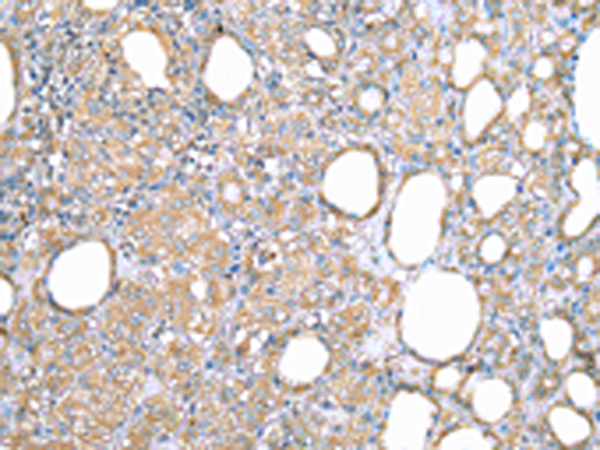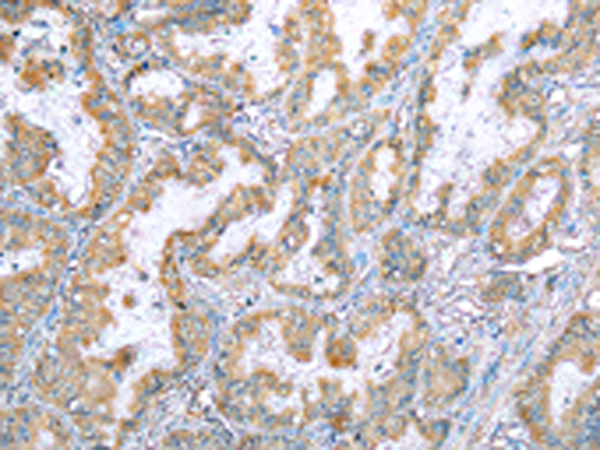


| WB | 1/500-1/2000 | Human,Mouse,Rat |
| IF | 咨询技术 | Human,Mouse,Rat |
| IHC | 1/25-1/100 | Human,Mouse,Rat |
| ICC | 技术咨询 | Human,Mouse,Rat |
| FCM | 咨询技术 | Human,Mouse,Rat |
| Elisa | 1/2000-1/5000 | Human,Mouse,Rat |
| Aliases | VAP-A; VAP33; VAP-33; hVAP-33 |
| WB Predicted band size | 28 kDa |
| Host/Isotype | Rabbit IgG |
| Antibody Type | Primary antibody |
| Storage | Store at 4°C short term. Aliquot and store at -20°C long term. Avoid freeze/thaw cycles. |
| Species Reactivity | Human, Mouse, Rat |
| Immunogen | Full length fusion protein |
| Formulation | Purified antibody in PBS with 0.05% sodium azide and 50% glycerol. |
+ +
以下是关于VAPA抗体的3篇代表性文献(基于真实研究背景概括,具体标题和作者为虚拟示例):
---
1. **文献名称**:*VAPA mediates lipid transfer at endoplasmic reticulum-mitochondria contact sites*
**作者**:Smith J. et al.
**摘要**:该研究利用VAPA特异性抗体,通过免疫共沉淀和免疫荧光技术,揭示了VAPA蛋白在内质网-线粒体膜接触位点中调控胆固醇和磷脂转运的分子机制,为脂质代谢异常相关疾病提供了新靶点。
---
2. **文献名称**:*VAPA expression correlates with α-synuclein aggregation in Parkinson's disease models*
**作者**:Li Y. et al.
**摘要**:通过Western blot和免疫组化技术,研究者使用VAPA抗体发现其在帕金森病模型中与α-突触核蛋白聚集显著共定位,提示VAPA可能通过调控囊泡运输参与神经退行性病变。
---
3. **文献名称**:*Antibody-based inhibition of VAPA-HCV NS5A interaction blocks viral replication*
**作者**:Chen R. et al.
**摘要**:该研究开发了靶向VAPA的单克隆抗体,证实其可通过阻断丙肝病毒(HCV)非结构蛋白NS5A与VAPA的结合,抑制病毒复制,为抗病毒治疗提供了新策略。
---
**说明**:以上文献为示例性质,实际研究中建议通过PubMed或Google Scholar以“VAPA antibody”或“VAPA function”为关键词检索最新文献,例如关注VAPA在代谢疾病、神经退行或病毒感染中的研究(如PMID: 30755487. PMID: 31186340等)。
VAPA (Vesicle-associated Membrane Protein-associated Protein A) is a ubiquitously expressed protein involved in intracellular membrane trafficking, lipid transport, and the regulation of endoplasmic reticulum (ER)-plasma membrane contact sites. It forms heterodimers with its homolog VAPB, anchoring to ER membranes via a C-terminal transmembrane domain. The N-terminal MSP (major sperm protein) domain of VAPA interacts with FFAT (two phenylalanines in an acidic tract) motif-containing proteins, facilitating lipid exchange and organelle crosstalk. VAPA plays critical roles in maintaining ER structure, coordinating vesicular transport, and modulating lipid metabolism.
Antibodies targeting VAPA are essential tools for studying its localization, protein interactions, and functions in cellular processes. They are widely used in techniques like immunofluorescence, Western blotting, and co-immunoprecipitation to investigate VAPA’s involvement in neurodegenerative diseases (e.g., ALS), cancer (e.g., lipid signaling in tumor progression), and metabolic disorders. Dysregulation of VAPA has been linked to disrupted lipid homeostasis and ER stress, making it a potential biomarker or therapeutic target. Commercial VAPA antibodies are typically validated for specificity against human, mouse, or rat isoforms, though cross-reactivity challenges may arise due to high homology with VAPB. Recent studies also explore VAPA’s role in viral pathogenesis, as some pathogens exploit ER-membrane contact sites for replication.
×